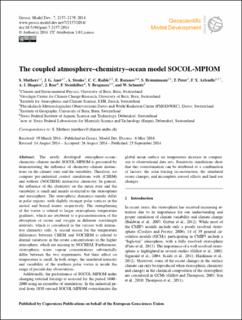Bitte benutzen Sie diese Kennung, um auf die Ressource zu verweisen:
https://doi.org/10.21256/zhaw-4653| Publikationstyp: | Beitrag in wissenschaftlicher Zeitschrift |
| Art der Begutachtung: | Peer review (Publikation) |
| Titel: | The coupled atmosphere–chemistry–ocean model SOCOL-MPIOM |
| Autor/-in: | Muthers, S. Anet, J. G. Stenke, A. Raible, C. C. Rozanov, E. Brönnimann, S. Peter, T. Arfeuille, F. X. Shapiro, A. I. Beer, J. Steinhilber, F. Brugnara, Y. Schmutz, W. |
| DOI: | 10.21256/zhaw-4653 10.5194/gmd-7-2157-2014 |
| Erschienen in: | Geoscientific Model Development |
| Band(Heft): | 7 |
| Seite(n): | 2157 |
| Seiten bis: | 2179 |
| Erscheinungsdatum: | 2014 |
| Verlag / Hrsg. Institution: | Copernicus |
| ISSN: | 1991-9603 1991-959X |
| Sprache: | Englisch |
| Fachgebiet (DDC): | 551: Geologie und Hydrologie |
| Zusammenfassung: | The newly developed atmosphere–ocean–chemistry–climate model SOCOL-MPIOM is presented by demonstrating the influence of chemistry–climate interactions on the climate state and the variability. Therefore, we compare pre-industrial control simulations with (CHEM) and without (NOCHEM) interactive chemistry. In general, the influence of the chemistry on the mean state and the variability is small and mainly restricted to the stratosphere and mesosphere. The atmospheric dynamics mainly differ in polar regions, with slightly stronger polar vortices in the austral and boreal winter, respectively. The strengthening of the vortex is related to larger stratospheric temperature gradients, which are attributed to a parameterisation of the absorption of ozone and oxygen in different wavelength intervals, which is considered in the version with interactive chemistry only. A second reason for the temperature differences between CHEM and NOCHEM is related to diurnal variations in the ozone concentrations in the higher atmosphere, which are missing in NOCHEM. Furthermore, stratospheric water vapour concentrations substantially differ between the two experiments, but their effect on temperature is small. In both setups, the simulated intensity and variability of the northern polar vortex is inside the range of present-day observations. Additionally, the performance of SOCOL-MPIOM under changing external forcings is assessed for the period 1600-2000 using an ensemble of simulations. In the industrial period from 1850 onward SOCOL-MPIOM overestimates the global mean surface air temperature increase in comparison to observational data sets. Sensitivity simulations show that this overestimation can be attributed to a combination of factors: the solar forcing reconstruction, the simulated ozone changes, and incomplete aerosol effects and land use changes. |
| URI: | https://digitalcollection.zhaw.ch/handle/11475/8908 |
| Volltext Version: | Publizierte Version |
| Lizenz (gemäss Verlagsvertrag): | CC BY 3.0: Namensnennung 3.0 Unported |
| Departement: | School of Engineering |
| Organisationseinheit: | Zentrum für Aviatik (ZAV) |
| Enthalten in den Sammlungen: | Publikationen School of Engineering |
Dateien zu dieser Ressource:
| Datei | Beschreibung | Größe | Format | |
|---|---|---|---|---|
| 2014_Anet_Coupled_atmosphere_chemistry_ocean_model.pdf | 3.85 MB | Adobe PDF |  Öffnen/Anzeigen |
Zur Langanzeige
Muthers, S., Anet, J. G., Stenke, A., Raible, C. C., Rozanov, E., Brönnimann, S., Peter, T., Arfeuille, F. X., Shapiro, A. I., Beer, J., Steinhilber, F., Brugnara, Y., & Schmutz, W. (2014). The coupled atmosphere–chemistry–ocean model SOCOL-MPIOM. Geoscientific Model Development, 7, 2157–2179. https://doi.org/10.21256/zhaw-4653
Muthers, S. et al. (2014) ‘The coupled atmosphere–chemistry–ocean model SOCOL-MPIOM’, Geoscientific Model Development, 7, pp. 2157–2179. Available at: https://doi.org/10.21256/zhaw-4653.
S. Muthers et al., “The coupled atmosphere–chemistry–ocean model SOCOL-MPIOM,” Geoscientific Model Development, vol. 7, pp. 2157–2179, 2014, doi: 10.21256/zhaw-4653.
MUTHERS, S., J. G. ANET, A. STENKE, C. C. RAIBLE, E. ROZANOV, S. BRÖNNIMANN, T. PETER, F. X. ARFEUILLE, A. I. SHAPIRO, J. BEER, F. STEINHILBER, Y. BRUGNARA und W. SCHMUTZ, 2014. The coupled atmosphere–chemistry–ocean model SOCOL-MPIOM. Geoscientific Model Development. 2014. Bd. 7, S. 2157–2179. DOI 10.21256/zhaw-4653
Muthers, S., J. G. Anet, A. Stenke, C. C. Raible, E. Rozanov, S. Brönnimann, T. Peter, et al. 2014. “The Coupled Atmosphere–Chemistry–Ocean Model SOCOL-MPIOM.” Geoscientific Model Development 7: 2157–79. https://doi.org/10.21256/zhaw-4653.
Muthers, S., et al. “The Coupled Atmosphere–Chemistry–Ocean Model SOCOL-MPIOM.” Geoscientific Model Development, vol. 7, 2014, pp. 2157–79, https://doi.org/10.21256/zhaw-4653.
Alle Ressourcen in diesem Repository sind urheberrechtlich geschützt, soweit nicht anderweitig angezeigt.